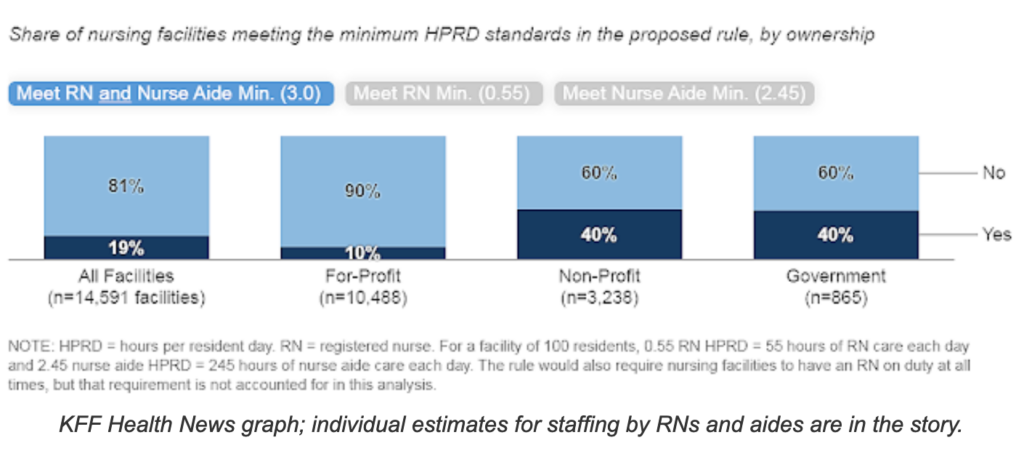90% of for-profit nursing homes would need more staff to meet proposed rules; 60% of others would, KFF Health News estimates

“Ninety percent of for-profit facilities would need to hire additional nursing staff, compared with 60% of non-profit and government facilities,” says the analysis by Alice Burns, Priya Chidambaram, Tricia Neuman and Robin Rudowitz.
In Kentucky, about two-thirds of nursing homes are for profit, and only 21% of all homes meet the proposed standard, which is about the same as the national figure of 19%, KFF Health News estimates.
The Centers for Medicare and Medicaid Services has proposed that nursing homes employ registared nurses for at least 0.55 hours per resident per day, and nurses’ aides for at least 2.45 hours per resident per day. The rule would also require facilities to have an RN working at all times.
|
Nursing homes say some of them might have to go out of business because they already have big problems finding enough nurses and nurses’ aides. To address that concern, the rules would be phased in, with some differences for rural and urban nursing facilities.
The first phase, starting 60 days after publication of the final rule, would require facilities to “assess the needs of each resident, include input from nursing facility staff and residents’ families or legal representatives, and develop a plan to meet required staffing levels given residents’ needs,” KFF notes.
Two years after publication, urban nursing homes would need round-the-clock RNs. For rural nursing homes, that would occur three years after publication. After that, the rules for number of nursing hours per resident day would kick in.
“Nursing facilities would also have to demonstrate good faith efforts to hire and retain staff and a financial commitment to staffing by reporting the total amount of money spent on direct care staff.” They could not get such exemptions “if they had any staffing-related violations” or had been designated as a Special Focus Facility “with a history of serious quality issues.
KFF explains, “Nearly half of facilities meet the RN requirement (52%) but only 28% meet the nurse aide requirement. . . . When looking at ownership of facilities that meet the RN requirement, a larger share of non-profit facilities would meet the 0.55 standard than for-profit and government facilities (75%, 44%, and 61%, respectively). When looking at nurse aides, about half of non-profit and government facilities meet the minimum staffing levels, compared with only 20% of for-profit facilities.”
And what about the workforce shortage? “As of June 2023, employment levels were still more than 11% below pre-pandemic levels for workers in skilled nursing care facilities and 3% below pre-pandemic levels for workers in elderly care facilities,” KFF reports. “Although fewer facilities would need to hire new RNs, those that do may find it difficult to compete with hospitals, many of which are also trying to increase the number of RNs they employ. To the extent that many nursing facilities receive hardship exemptions on account of workforce shortages, the effects of the proposed rule on minimum staffing levels will be muted.”